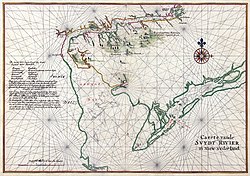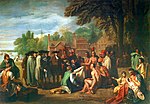
The Dutch West India Company or WICDutch pronunciation:[ʋɛstˈɪndisəkɔmpɑˈɲi] was a chartered company of Dutch merchants as well as foreign investors, formally known as GWC. Among its founders were Reynier Pauw, Willem Usselincx (1567–1647) and Jessé de Forest (1576–1624). On 3 June 1621, it was granted a charter for a trade monopoly in the Dutch West Indies by the Republic of the Seven United Netherlands and given jurisdiction over Dutch participation in the Atlantic slave trade, Brazil, the Caribbean, and North America.
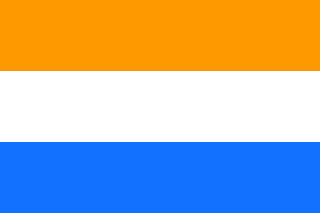
New Netherland was a 17th-century colonial province of the Dutch Republic located on the east coast of what is now the United States of America. The claimed territories extended from the Delmarva Peninsula to Cape Cod. Settlements were established in what became the states of New York, New Jersey, Delaware, and Connecticut, with small outposts in Pennsylvania and Rhode Island.

Kiliaen van Rensselaer was a Dutch diamond and pearl merchant from Amsterdam who was one of the founders and directors of the Dutch West India Company, being instrumental in the establishment of New Netherland.

Fort Orange was the first permanent Dutch settlement in New Netherland; the present-day city of Albany, New York developed at this site. It was built in 1624 as a replacement for Fort Nassau, which had been built on nearby Castle Island and served as a trading post until 1617 or 1618, when it was abandoned due to frequent flooding. Both forts were named in honor of the Dutch House of Orange-Nassau. Due to a dispute between the Director-General of New Netherland and the patroonship of Rensselaerswyck regarding jurisdiction over the fort and the surrounding community, the fort and community became an independent municipality, paving the way for the future city of Albany. After the English reconquered the region they soon abandoned Fort Orange in favor of a new fort: Fort Frederick, constructed in 1676.
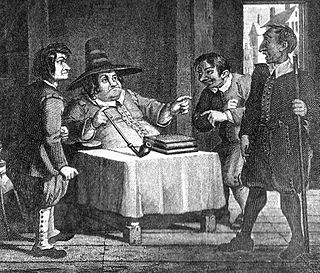
Wouter van Twiller was an employee of the Dutch West India Company and the fourth Director of New Netherland. He governed from 1632 until 1638, succeeding Peter Minuit, who was recalled by the Dutch West India authorities in Amsterdam for unknown reasons.
In the United States, a patroon was a landholder with manorial rights to large tracts of land in the 17th century Dutch colony of New Netherland on the east coast of North America. Through the Charter of Freedoms and Exemptions of 1629, the Dutch West India Company first started to grant this title and land to some of its invested members. These inducements to foster colonization and settlement are the basis for the patroon system. By the end of the eighteenth century, virtually all of the American states had abolished primogeniture and entail; thus patroons and manors evolved into simply large estates subject to division and leases.

Rensselaerswyck was the name of Dutch colonial patroonship and later an English manor owned by the van Rensselaer family located in the present-day Capital District of New York in the United States.

Jeremias van Rensselaer was the third son of Kiliaen van Rensselaer, one of the founders and directors of the Dutch West India Company who was instrumental in the establishment of New Netherland and was created the first patroon of the Manor of Rensselaerswyck. Jeremias van Rensselaer was the acting patroon of the Manor of Rensselaerswyck, and the first of his family to establish himself permanently in America.

Adriaen Cornelissen van der Donck was a lawyer and landowner in New Netherland after whose honorific Jonkheer the city of Yonkers, New York, is named. Although he was not, as sometimes claimed, the first lawyer in the Dutch colony, Van der Donck was a leader in the political life of New Amsterdam, and an activist for Dutch-style republican government in the Dutch West India Company-run trading post.

Pavonia was the first European settlement on the west bank of the North River that was part of the seventeenth-century province of New Netherland in what would become the present Hudson County, New Jersey.

Zwaanendael or Swaanendael was a short-lived Dutch colonial settlement in Delaware. It was built in 1631. The name is archaic Dutch for "swan valley." The site of the settlement later became the town of Lewes, Delaware.

Knight Michiel Reiniersz Pauw was a director of the Dutch West India Company (WIC) between 1621 and 1636. He is buried at at Nieuwe Kerk, Amsterdam.

New Netherland was the 17th century colonial province of the Republic of the Seven United Netherlands on the northeastern coast of North America. The claimed territory was the land from the Delmarva Peninsula to southern Cape Cod. The settled areas are now part of the Mid-Atlantic states of New York, New Jersey, and Delaware, with small outposts in Connecticut and Pennsylvania. Its capital of New Amsterdam was located at the southern tip of the island of Manhattan on the Upper New York Bay.

New Netherlanders were residents of New Netherland, the seventeenth-century colonial outpost of the Republic of the Seven United Netherlands on the northeastern coast of North America, centered on the Hudson River and New York Bay, and in the Delaware Valley.
Van Rensselaer Island was an island in the Hudson River opposite the city of Albany, New York. The island was also known as de Laet's Island, Kalebacker's Island, Boston Island and B&A Island, the last two names in reference to the Boston and Albany Railroad. The island stretched from Mill Creek north to the Livingston Avenue Bridge. Van Rensselaer Island is now connected to the City of Rensselaer, and is no longer an island.
Johan van Rensselaer also Johannes van Rensselaer, second patroon of the Manor of Rensselaerswyck, was the eldest son of Kiliaen van Rensselaer, and his only son by his first wife, Hillegonda van Bylaer.

Jan Baptist van Rensselaer was the second son of Kiliaen van Rensselaer, the first Patroon of the Manor of Rensselaerswyck.

The Map of Rensselaerswyck is a map created during the 1630s, probably 1632, at the request of the owner of the Manor of Rensselaerswyck, Kiliaen van Rensselaer, Dutch jeweler and patroon. Rensselaerswyck was the only successful patroonship within the colony of New Netherland, settled by the Dutch West India Company at the behest of the States-General of the United Netherlands. The map is believed to be the first ever commissioned or created of Rensselaerswyck.
Beeren Island, also known as Barren Island or Bear Island, is an island in the Hudson River within the town of Coeymans, New York. It lies 11 miles (18 km) south of the city of Albany, and is at the border of four counties, Albany, Greene, Columbia, and Rensselaer. Beeren Island was once referred to as Mach-a-wa-meck, which may come from mashq (bear) and wamock (enough), meaning "place of many bears" and would make it in agreement with the Dutch name.
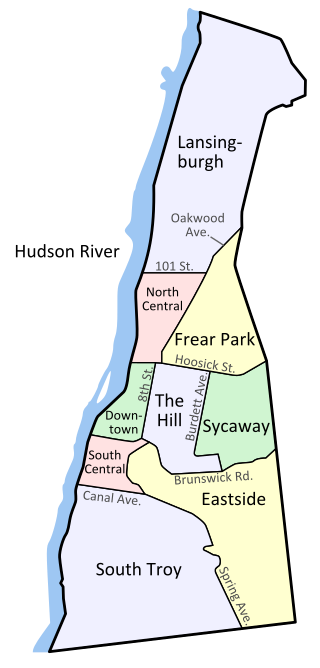
The history of Troy, New York extends back to the Mohican Indians. Troy is a city on the east bank of the Hudson River about 5 miles (8.0 km) north of Albany in the US State of New York.


